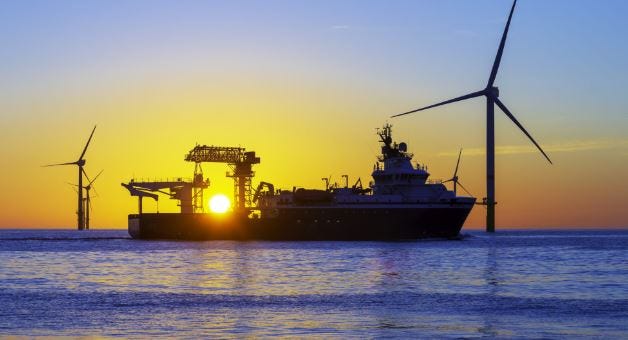The subterfuge of language employed by corporate bodies, councils and the government these days never ceases to amuse me. The average person on the street needs to be a code cracker akin to the German "Enigma" Cipher machine in WW2 to decode out what is actually being said.
I call this subterfuge because this tactic is employed to camouflage something that will be deeply unpopular, for those who have to pay for it, but gives those proposing it the ability to later claim to have been open and transparent.
Offshore Wind Permits Coming - Brown
This week there was an article in the energy news titled Offshore wind permits coming - Brown.
It’s a good article exploring the Government’s roadmap to introducing the first offshore wind permitting block offer by late 2025. I can only assume that this will be something akin to an Oil & Gas permitting block offer that gives the Offshore Wind Company legal access to install equipment and operate in the permit area for a pre-determined period, probably 30 years with extension options, or something along those lines.
The key question posed by the article is why offshore wind was this not included in the proposed fast track consenting regulations. The answer is relatively simple, it’s a very complex legal topic. The permit areas will cross two jurisdictions, territorial waters (0-12Nm) managed by regional councils, and the EEZ (12Nm - 200Nm) managed by the EPA. The RMA is not structured to deal with this level of infrastructure inside 12Nm and the EPA will single handedly be able to add several cents per kW/hr over the lifecycle of a field with their wildly pedantic regulatory approach.
There will also be a lot of stakeholders. Offshore wind farms are quickly becoming associated with detrimental impacts to sea birds and whales. Expect environmental interest groups to mount strong challenges, as will Iwi and the fishing industry.
Another key issue is the decommissioning regulations. I would assume that it will be akin to oil and gas, and that all infrastructure will need to be removed. As we know from my earlier post “Eye watering costs of offshore wind” this will easily be as expensive as the initial development. As such it must be included in any permitting framework. The beleaguered taxpayer would not want to be lumped with a double digit billion-dollar decommissioning bill for each 1GW wind farm.
Eye watering numbers for offshore wind!
I hope you are all having a great summer so far. After a diesel powered road trip in the top of the south with the kids, lots of swimming and a spot of hunting it’s time to get back into the blog. Today let’s have a look into the economics of offshore wind.
Show me the money!!
However, the bit that caught my attention was the comments from MBIE.
“While a well-designed regulatory framework is essential for offshore wind it is unlikely, on its own, sufficient to deliver offshore wind in New Zealand.”
“As outlined in recent advice to the minister, to fully enable offshore wind a range of other policy levers are likely to be required. One of these measures is revenue stabilisation, which would be a material departure from the current New Zealand electricity market set-up.”
Ok we will need to crank up the Enigma machine to explore what “revenue stabilization” means?
In essence it means that offshore wind generators need to be paid a fixed amount for what is generated regardless of the what the market is doing. This is typically known as the “strike price”. The UK Govt recently increased the strike price of offshore wind after a failure to receive any bids for new blocks and after lobbying by the offshore wind industry.
The maximum strike price has been increased by 66% for offshore wind projects, from £44/MWh to £73/MWh, and by 52% for floating offshore wind projects, from £116/MWh to £176/MWh ahead of Allocation Round 6 (AR6) next year.
Wow 52% to £176/MWh, that’s gonna hurt!
I’m sure the politicians and media breathlessly told me renewables were cheap??
What’s even more concerning is that this is inflation proofed meaning that the strike price goes up as CPI goes up. So, your offshore wind will always be expensive. Certain capacity built under this arrangement can also be re-bid if the minimum strike price is raised by the government.
Some even more concerning schemes in the US guarantee a certain amount per MW installed regardless of if it is actually generating anything.
Coming back to MBIE we can see this is clearly the path they are intending to take.
Offshore wind is roughly twice the cost of onshore wind. That difference is projected to narrow in coming years but advocates say offshore developments will still be more costly than other renewables and won't proceed without additional support from government – possibly in the form of state-based contracts for differences.
“Additional support from government” put through Enigma machine = taxpayers and consumers. That’s us folks.
Prices will only go one way, and that’s up.






Yeah , tell me again how cheap renewables are ? 🤑